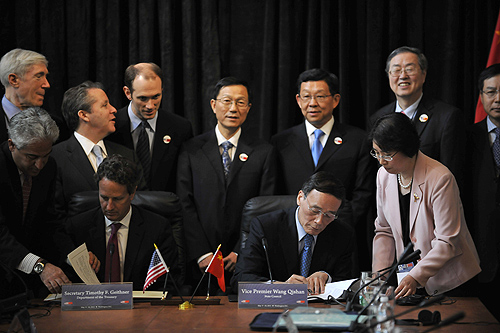Building the Sino-U.S. bridge
- By Wang Honggang
 0 Comment(s)
0 Comment(s) Print
Print E-mail
Beijing Review, August 18, 2011
E-mail
Beijing Review, August 18, 2011
|
|
|
Milestone framework: Chinese Vice Premier Wang Qishan (second right, front) and U.S. Treasury Secretary Timothy Geithner sign a framework agreement on economic cooperation during the third round of the Sino-U.S. Strategic and Economic Dialogue in Washington, D.C. on May 10 [Beijing Review/Wang Fengfeng] |
Held after a year of tension between China and the United States, and following a meeting between the presidents of both nations in January, the third round of the Sino-U.S. Strategic and Economic Dialogue (S&ED) had everyone's attention. The world watched wide-eyed to see if the meeting, convened in Washington, D.C. on May 9-10, could usher in a new wave of healthy and stable development in Sino-U.S. relations.
A fragile relationship
Compared to tense relations in 2010, Sino-U.S. ties seem to be in calmer waters. This is no doubt thanks to the January summit between Chinese President Hu Jintao and U.S. President Barack Obama. Hu's visit was regarded as the "most important high-level visit in Sino-U.S. relations" since Chinese leader Deng Xiaoping's trip to the United States in 1979 shortly after the two countries established diplomatic ties.
The summit effectively reversed the downward spiral in bilateral relations and enhanced the two countries' mutual understanding and trust. A Joint Statement issued after official talks stated that China and the United States would build a "cooperative partnership based on mutual respect and mutual benefit." The statement addressed problems caused by the previous vague definition of the nature of Sino-U.S. relations, and became a guideline for their future ties.
Also, unrest in the Middle East distracted U.S. attention from China, which helped lessen tensions in bilateral relations in recent months. On January 14, Tunisian President Zine El Abidine Ben Ali was ousted after ruling the country for more than two decades. Quickly, Tunisia's domestic riots triggered a sweeping wave of disturbances across the Middle East.
Chaos in the Middle East had barely stopped when a massive earthquake and tsunami hit Japan on March 11, a U.S. ally in the Asia-Pacific region. This left Japan incapable of addressing contentious issues, particularly those involving China.
Against this backdrop, disputes between China and the United States were temporarily played down or covered up. This peace, however, is fragile. Chronic disputes over U.S. leaders' meetings with the Dalai Lama, U.S. arms sales to Taiwan, the Korean Peninsula nuclear issue, as well as the United States' interference in territorial disputes in the East China Sea and the South China Sea will continue to hinder bilateral relations.
Since unrest broke out in the Middle East, the Obama administration has put increased momentum behind promoting democracy around the globe. It ratcheted up pressure on China by criticizing its human rights record, sparking strong reactions from Beijing.
Moreover, China's first aircraft carrier is about to set sail. The United States and its allies are worried that could tilt the balance of power in the Asia-Pacific region. The United States is also concerned the development of the BRICS club, consisting of Brazil, Russia, India, China and South Africa, may in some way harm its interests. U.S. Secretary of State Hillary Clinton said the United States was in competition for global influence with China at a Senate hearing in March. These have all added to the complexity of Sino-U.S. relations.






